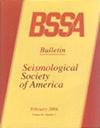Panel Review of the USGS 2023 Conterminous U.S. Time-Independent Earthquake Rupture Forecast
IF 2.9
3区 地球科学
Q2 GEOCHEMISTRY & GEOPHYSICS
引用次数: 1
Abstract
This report documents the assessment by the U.S. Geological Survey (USGS) Earthquake Rupture Forecast (ERF) Review Panel of the draft ERF for the conterminous United States (CONUS-ERF23) proposed for the 2023 update of the National Seismic Hazard Model (NSHM23). Panel members participated with the ERF Development Team in several verification and validation exercises, including spot checks of the hazard estimates at key localities. The ERF23 forecast is substantially different from its predecessor, yielding relative differences in hazard that exceed ±50% in some low-hazard areas. These stem primarily from the new model ingredients—new faults, revised deformation rates, and updated seismicity catalogs—rather than from changes in the modeling methodology. The panel found that the main hazard changes are scientifically justified at the long return periods (≥475 yr) for which NSHM23 is applicable. Based on its evaluation of the model, the panel offered six actionable recommendations for improvements to the draft ERF23 for the western United States and two for the Cascadia subduction zone. All eight recommendations were adopted by the USGS for the revised ERF, as documented by Field et al. (2023). The panel concluded that CONUS-ERF23 represents a significant scientific advance over ERF18 and should be incorporated, after suitable revision, into NSHM23. The panel also considered changes to the CONUS-ERF that cannot be feasibly implemented in NSHM23 but could lead to future improvements. Among these aspirational recommendations, the panel prioritized the development of time-dependent extensions of ERF23 that include models of seismic renewal and clustering. The panel endorsed USGS efforts to extend the NSHM to a national earthquake forecasting enterprise capable of continually updating and disseminating authoritative information about future earthquake occurrence through a well-designed hazard-risk interface. Operational earthquake forecasting will place new and heavy demands on USGS cyberinfrastructure, requiring a more integrated approach to software development and workflow management.美国地质调查局(USGS)2023 年美国大陆不定时地震破裂预测专家小组审查报告
本报告记录了美国地质调查局(USGS)地震破裂预测(ERF)审查小组对美国大陆地区ERF草案(CONUS-ERF23)的评估,该草案建议用于2023年国家地震危险性模型(NSHM23)的更新。专家组成员与 ERF 开发团队一起参加了多次验证和确认工作,包括在关键地点对灾害估计值进行抽查。ERF23 预测与前者有很大不同,在一些低灾害区,灾害的相对差异超过 ±50%。这些差异主要源于新的模型成分--新的断层、修订的变形率和更新的地震目录,而非建模方法的变化。专家小组认为,在 NSHM23 适用的长重现期(≥475 年),主要的危害变化是科学合理的。在对模型进行评估的基础上,专家小组对美国西部的 ERF23 草案提出了六项可行的改进建议,对卡斯卡迪亚俯冲带提出了两项改进建议。美国地质调查局在修订 ERF 时采纳了所有八项建议,Field 等人(2023 年)对此进行了记录。专家小组得出结论,CONUS-ERF23 与 ERF18 相比在科学上有重大进步,应在适当修订后纳入 NSHM23。专家小组还考虑了对 CONUS-ERF 的修改,这些修改在 NSHM23 中无法可行地实施,但可在未来加以改进。在这些期望的建议中,专家小组优先考虑开发 ERF23 的随时间变化的扩展,其中包括地震更新和群集模型。专家小组赞同美国地质调查局努力将 NSHM 扩展为国家地震预报企业,该企业能够通过精心设计的危害风险界面,不断更新和传播有关未来地震发生的权威信息。业务地震预报将对美国地质调查局的网络基础设施提出新的和更高的要求,需要对软件开发和工作流程管理采取更加综合的方法。
本文章由计算机程序翻译,如有差异,请以英文原文为准。
求助全文
约1分钟内获得全文
求助全文
来源期刊

Bulletin of the Seismological Society of America
地学-地球化学与地球物理
CiteScore
5.80
自引率
13.30%
发文量
140
审稿时长
3 months
期刊介绍:
The Bulletin of the Seismological Society of America, commonly referred to as BSSA, (ISSN 0037-1106) is the premier journal of advanced research in earthquake seismology and related disciplines. It first appeared in 1911 and became a bimonthly in 1963. Each issue is composed of scientific papers on the various aspects of seismology, including investigation of specific earthquakes, theoretical and observational studies of seismic waves, inverse methods for determining the structure of the Earth or the dynamics of the earthquake source, seismometry, earthquake hazard and risk estimation, seismotectonics, and earthquake engineering. Special issues focus on important earthquakes or rapidly changing topics in seismology. BSSA is published by the Seismological Society of America.
 求助内容:
求助内容: 应助结果提醒方式:
应助结果提醒方式:


